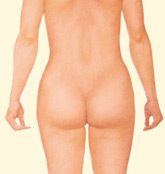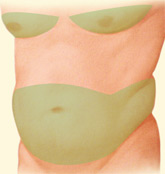- Home
- Dr.English
 Cosmetic Surgery
Cosmetic Surgery
- At A Glance
 Facial Procedures
Facial Procedures
 Breast Procedures
Breast Procedures
 Body Lift & Contouring
Body Lift & Contouring
 Non-Surgical
Non-Surgical
- "Mommy
Makeovers"
 Reconstruction
Reconstruction
- Location
- Photos
 Contact
Contact

S.A.F.E. Liposuction
SAFE stands for: fat Separation, fat Aspiration, and Fat Equalization
This term designates a particular liposuction technique that can lead to a more pleasing postoperative contour, especially in circumferential (all the way around) treatment, such as for the torso and thighs. The acronym, SAFE, stands for fat Separation, fat Aspiration, and Fat Equalization. It is a safe technique when properly performed. (The acronym is not used to imply that the procedure is any safer than other techniques of liposuction.)
The technique was developed and perfected by plastic surgeon Dr. Simeon Wall, Jr. Dr. English visited Dr. Wall to personally learn this technique and has been using it in his practice since 2010, with rewarding and improved liposuction results and contours. It can provide impressive results in the treatment of first-time liposuction patients, and is a very helpful adjunct for contour correction in secondary liposuction or body contouring procedures.
Liposuction in General:
Also known as lipoplasty, liposuction slims and reshapes specific areas of the body by removing excess fat deposits, improving your body contours and proportion, and ultimately, enhancing your self-image.
Enhancing your appearance with liposuction
Typical Questions and some facts about these procedures:
- Why Liposuction?
- Procedural Steps
- Important facts about the safety and risks of tissue fillers
- My recovery
- Results and outlook of the procedure
- How much will soft tissue augmentation cost?
- Terms you should know
Why Liposuction?
Despite good health and a reasonable level of fitness, some people may still have a body with disproportionate contours due to localized fat deposits. These areas may be due to family traits rather than a lack of weight control or fitness.
Liposuction slims and reshapes specific areas of the body by removing excess fat deposits, improving your body contours and proportion, and ultimately, enhancing your self-image.
Liposuction techniques may be used to reduce localized fat deposits of the:
- Thighs
- Hips and buttocks
- Abdomen and waist
- Upper arms
- Back
- Inner knee
- Chest area
- Cheeks, chin and neck
- Calves and ankles
In some cases, liposuction is performed alone, in other cases it is used with plastic surgery procedures such as a facelift, breast reduction or a tummy tuck.
What it won’t do:
Liposuction is not a treatment for obesity or a substitute for proper diet and exercise. It is also not an effective treatment for cellulite, the dimpled skin that typically appears on the thighs, hips and buttocks, or loose saggy skin.
Procedural Steps: What happens during liposuction?
Step 1: Anesthesia
Medications are administered for your comfort during the surgical procedures. The choices include intravenous sedation and general anesthesia. Dr. English will recommend the best choice for you.
Step 2: The incision
Liposuction is performed through small, inconspicuous incisions.
First, sterile liquid solution is infused to reduce bleeding and trauma. Then a thin hollow tube, or cannula, is inserted through these incisions to loosen excess fat using a controlled back and forth motion.
The dislodged fat is then suctioned out of the body using a surgical vacuum or syringe attached to the cannula.
Problem areas that can be addressed with liposuction:

|

|

|

|

|

|

|

|
Step 3: See the results
Your improved body contour will be apparent when the swelling and fluid retention commonly experienced following liposuction subside.
With continued practices of healthy diet and fitness, the loss of excess fatty tissue should be permanently maintained. However, substantial weight gain can alter an otherwise permanent result.
Important facts about the safety and risks of liposuction:
The decision to have liposuction is extremely personal and you’ll have to decide if the benefits will achieve your goals and if the risks and potential complications are acceptable.
Dr. English will explain in detail the risks associated with surgery. You will be asked to sign consent forms to ensure that you fully understand the procedure you will undergo and any risks or potential complications.
Possible risks of liposuction include:
- Uneven contours
- Rippling or loose skin
- Skin or nerve damage
- Irregular pigmentation
- Infection
- Fat clots
- Blood clots
- Excessive fluid loss or fluid accumulation
- Unfavorable scarring
- Thermal burn or heat injury from ultrasound with the ultrasound-assisted lipoplasty technique
- Anesthesia risks
- Bleeding (hematoma)
- Change in skin sensation
- Skin discoloration or swelling
- Asymmetry
- Pain, which may persist
- Damage to deeper structures such as nerves, blood vessels, muscles, lungs, and abdominal organs
- Poor wound healing
- Persistent swelling in the legs
- Deep vein thrombosis, cardiac and pulmonary complications
- Possibility of revisional surgery
Is it right for me?
If you are bothered by excess fat deposits - located anywhere on your body - that don’t respond to diet or exercise, liposuction may be right for you.
Ideal candidates for liposuction are:
- Adults within 30% of their ideal weight who have firm, elastic skin and good muscle tone
- Healthy individuals who do not have a life-threatening illness or medical conditions that can impair healing
- Non-smokers
- Individuals with a positive outlook and specific goals in mind for body contouring
Be sure to ask questions: It’s very important to ask Dr. English questions about your liposuction procedure. It’s natural to feel some anxiety, whether it’s excitement for your anticipated new look or a bit of preoperative stress. Don’t be shy about discussing these feelings with Dr. English.
Be careful.
Following Dr. English’s instructions is key to the success of your surgery. It is important that the surgical incisions are not subjected to excessive force, swelling, abrasion, or motion during the time of healing. You will be given specific instructions on how to care for yourself.
My recovery
Once your procedure is completed, a compression garment or elastic bandages may cover treatment areas. These help to control swelling and compress the skin to your new body contours.
In addition, small temporary drains may be placed in existing incisions beneath the skin to remove any excess blood or fluid.
You will be given specific instructions that may include: How to care for the surgical site(s), medications to apply or take orally to aid healing and reduce the potential for infection, specific concerns to look for at the surgical site or in your general health, and when to follow up with Dr. English.
A special note:
Secondary procedures may sometimes be recommended to reduce excess skin. Special considerations are needed when large amounts - usually more than 5 liters of fat - are suctioned.
When you go home
If you experience shortness of breath, chest pains, or unusual heart beats, seek medical attention immediately. Should any of these complications occur, you may require hospitalization and additional treatment.
The practice of medicine and surgery is not an exact science. Although good results are expected, there is no guarantee. In some situations, it may not be possible to achieve optimal results with a single surgical procedure and another surgery may be necessary.
Will the results be long-lasting?
It may take several months for the swelling to fully dissipate. As it does, your new contours and enhanced self-image should continue to develop.
The fulfillment you feel from the initial results of liposuction should continue as long as you control your weight and maintain a healthy lifestyle.
A significant weight gain can reverse your results. Following liposuction, your slimmer and better-proportioned body should more accurately reflect the healthy and active life you lead.
How much will soft tissue augmentation cost?
Cost is always a consideration in elective surgery. Prices for injectable fillers can vary widely. A surgeon’s cost may vary based on his or her experience as well as geographic office location.
Financing plans are available to qualified patients, so be sure to ask.
Cost may include:
- Surgeon’s fee
- Hospital or surgical facility costs
- Anesthesia fees
- Prescriptions for medication
- Post-surgery garments
- Medical tests
Your satisfaction involves more than a fee.
When choosing a plastic surgeon for soft tissue augmentation, remember that the surgeon’s experience and your comfort with him or her are just as important as the final cost of the surgery.
Most health insurance does not cover cosmetic surgery or its complications.
Terms you should know:
- Breast reduction: Also known as reduction mammaplasty, reduction of breast size by surgery.
- Cannula: A thin, hollow tube used during liposuction to loosen excess fat.
- Facelift: A surgical procedure, also known as rhytidectomy, to reduce sagging of the mid-face, jowls and neck.
- General anesthesia: Drugs and/or gases used during an operation to relieve pain and alter consciousness.
- Hematoma: Blood pooling beneath the skin.
- Intravenous sedation: Sedatives administered by injection into a vein to help you relax.
- Lipoplasty: Another term for liposuction. Liposuction: Also called lipoplasty or suction lipectomy, this procedure vacuums out fat from beneath the skin’s surface to reduce fullness.
- Local anesthesia: A drug injected directly to the site of an incision during an operation to relieve pain.
- Suction lipectomy: Another term for liposuction.
- Sutures: Stitches used by surgeons to hold skin and tissue together.
- Tumescent or super-wet liposuction: Involves an infusion of saline solution with adrenaline and possibly anesthetic prior to removal of excess fat.
- Tummy tuck: A surgical procedure, also known as abdominoplasty, to correct the apron of excess skin hanging over your abdomen.
- Ultrasound-assisted lipoplasty: Uses ultrasonic energy to liquefy excess fat prior to surgical suctioning.
Site Map | Contact Us | Privacy
Copyright 2013-2024 J.Martin English, MD
 Dr. English accepts CareCredit to help patients say "yes" to the procedures they want and need.
Dr. English accepts CareCredit to help patients say "yes" to the procedures they want and need.
 Dr. English also works with Prosper Healthcare Lending; the premier financing company in the cosmetic surgery industry.
Dr. English also works with Prosper Healthcare Lending; the premier financing company in the cosmetic surgery industry.